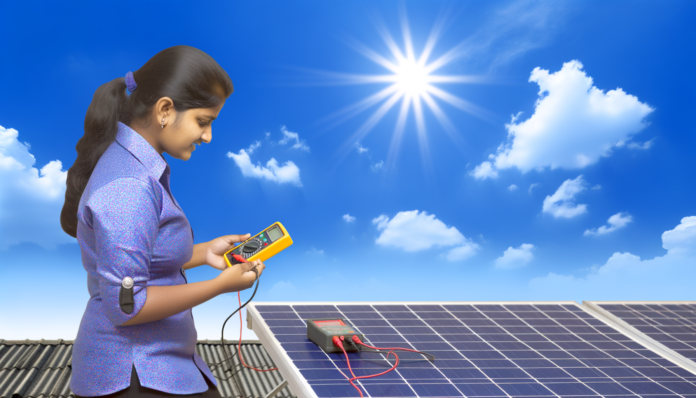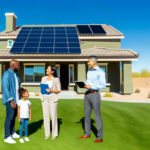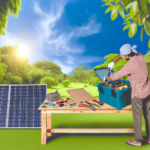Introduction to Solar Power Systems
Understanding Solar Power
Solar power harnesses energy from the sun and converts it into electricity using photovoltaic (PV) cells. These cells are typically made from silicon and are capable of generating an electric current when exposed to sunlight. This process is known as the photovoltaic effect. Solar power systems can be used for a variety of applications, from small-scale residential setups to large-scale solar farms that supply electricity to the grid.
Components of a Solar Power System
A typical solar power system consists of several key components:
- Solar Panels: These are the primary components that capture sunlight and convert it into direct current (DC) electricity.
- Inverter: The inverter converts the DC electricity generated by the solar panels into alternating current (AC) electricity, which is used by most household appliances.
- Battery Storage: Batteries store excess electricity generated during the day for use at night or during periods of low sunlight.
- Charge Controller: This device regulates the voltage and current coming from the solar panels to the batteries, preventing overcharging and prolonging battery life.
- Mounting System: This includes the racks and hardware used to secure the solar panels to rooftops or the ground.
- Wiring and Electrical Components: These include all the cables, connectors, and switches needed to connect the system components and integrate them with the home’s electrical system.
Benefits of Solar Power
Solar power offers numerous advantages, making it an increasingly popular choice for both residential and commercial energy needs:
- Renewable Energy Source: Solar power is a renewable resource, meaning it won’t run out as long as the sun continues to shine.
- Reduces Electricity Bills: By generating your own electricity, you can significantly reduce or even eliminate your monthly electricity bills.
- Low Maintenance Costs: Solar power systems require minimal maintenance. Most solar panels come with warranties of 20-25 years, and regular cleaning and occasional inspections are usually sufficient to keep them running efficiently.
- Environmental Benefits: Solar power is a clean energy source that produces no greenhouse gas emissions, reducing your carbon footprint and helping combat climate change.
- Energy Independence: By generating your own electricity, you become less dependent on the grid and less vulnerable to power outages and price fluctuations.
- Increases Property Value: Homes equipped with solar power systems often have higher property values and are more attractive to buyers.
In summary, understanding the basics of solar power, its components, and its benefits can help you make informed decisions about adopting this sustainable energy source. Whether you’re looking to reduce your electricity bills, minimize your environmental impact, or gain energy independence, solar power offers a viable and increasingly affordable solution.
Common Issues in Solar Power Systems
Performance Drops
One of the most frequent issues in solar power systems is a drop in performance. This can be caused by several factors, including shading, dirt accumulation, and panel degradation. **Shading** from trees, buildings, or other obstructions can significantly reduce the amount of sunlight reaching the panels, thereby decreasing their efficiency. **Dirt and debris** such as dust, bird droppings, and leaves can also block sunlight and should be cleaned off regularly. **Panel degradation** is a natural process where the efficiency of solar panels decreases over time, typically at a rate of about 0.5% to 1% per year. Regular maintenance and monitoring can help identify and mitigate these issues early.
Battery Problems
Batteries are crucial for storing the energy generated by solar panels, especially in off-grid systems. Common battery issues include **overcharging, undercharging, and capacity loss**. Overcharging can lead to overheating and potential fire hazards, while undercharging can reduce the battery’s lifespan. Capacity loss occurs naturally over time but can be accelerated by improper maintenance. To ensure battery health, regularly check the battery’s charge levels and condition. **Replacing faulty batteries** and ensuring proper charging protocols can help maintain system efficiency.
Inverter Issues
Inverters convert the DC electricity generated by solar panels into AC electricity used by most household appliances. **Inverter issues** can manifest as error messages, shutdowns, or reduced efficiency. Common causes include **faulty installation, capacity mismatch, and power surges**. To troubleshoot, start by **resetting the inverter** and checking for any error codes. **Updating the inverter firmware** can also resolve some issues. If problems persist, consult the inverter manual or contact a professional technician for further assistance.
Wiring and Connection Faults
Faulty wiring and poor connections can lead to significant energy losses and even pose safety risks. **Loose or damaged wires** can cause short-circuiting and system shutdowns. Regularly inspect all wiring and connections for signs of wear, corrosion, or looseness. **Tighten or replace** any faulty components to ensure optimal electrical conductivity. Using a multimeter to check the voltage at different points in the system can help identify problem areas. Proper installation and regular maintenance are key to preventing wiring and connection faults.
By understanding and addressing these common issues, you can ensure that your solar power system operates efficiently and reliably, providing you with clean, renewable energy for years to come.
Diagnosing Solar Power System Issues
Visual Inspection
A thorough visual inspection is the first step in diagnosing issues with your solar power system. This process involves examining all components of the system for any visible signs of damage or wear. Here are some key points to consider:
- Solar Panels: Check for cracks, discoloration, or warping. Ensure there is no dirt, dust, or debris obstructing the panels, as these can significantly reduce efficiency.
- Wiring and Connections: Inspect all wiring for signs of wear, corrosion, or loose connections. Pay special attention to junction boxes and combiner boxes where multiple wires converge.
- Inverter: Look for any physical damage, overheating, or error messages displayed on the inverter. Ensure that all connections are secure and free from corrosion.
- Mounting Structures: Check the stability and integrity of the mounting structures. Look for any signs of rust or damage that could compromise the system’s stability.
Regular visual inspections can help identify potential issues before they become major problems, ensuring the longevity and efficiency of your solar power system.
Using Monitoring Tools
Monitoring tools are essential for diagnosing issues in a solar power system. These tools provide real-time data and historical performance metrics, allowing you to identify and address problems quickly. Here are some commonly used monitoring tools:
- Solar Monitoring Software: Most modern solar systems come with monitoring software that tracks energy production, system performance, and alerts you to any anomalies. This software can be accessed via a computer or smartphone, providing convenient and comprehensive monitoring.
- Clamp Meters: Tools like the Fluke 393 FC Solar Clamp Meter are invaluable for measuring voltage, current, and power output. These meters can help you pinpoint issues in specific components, such as PV panels, inverters, and combiner boxes.
- Multimeters: A multimeter can measure voltage, current, and resistance, helping you diagnose electrical issues within the system. Use it to check the output of individual panels, the inverter, and other components.
By utilizing these monitoring tools, you can gain a deeper understanding of your system’s performance and quickly identify any issues that need attention.
Checking System Performance Metrics
Evaluating system performance metrics is crucial for diagnosing issues in your solar power system. Here are some key metrics to monitor:
- Energy Production: Compare the actual energy production to the expected output based on your system’s specifications and local weather conditions. Significant deviations may indicate issues such as shading, panel degradation, or inverter problems.
- Voltage and Current Levels: Measure the voltage and current at various points in the system, including the output of individual panels, the input and output of the inverter, and the connections in the combiner box. Abnormal readings can help identify faulty components or wiring issues.
- Temperature: Monitor the temperature of the panels and the inverter. Overheating can reduce efficiency and indicate potential issues with cooling or ventilation.
- Error Codes and Alerts: Pay attention to any error codes or alerts generated by the monitoring software or displayed on the inverter. These can provide valuable clues about the nature and location of the problem.
Regularly checking these performance metrics can help you maintain optimal system performance and quickly address any issues that arise. By combining visual inspections, monitoring tools, and performance metrics, you can effectively diagnose and troubleshoot common issues in your solar power system.
Troubleshooting Performance Drops
When your solar power system isn’t delivering the expected performance, it can be frustrating and concerning. Performance drops can be caused by various factors, including shading, dirty panels, and panel degradation. This section will guide you through identifying and resolving these common issues to ensure your solar power system operates at its best.
Identifying Shading Problems
Shading is one of the most common causes of reduced solar panel performance. Even a small amount of shade can significantly impact the efficiency of your solar panels. Here are steps to identify and address shading issues:
1. **Conduct a Site Survey**: Regularly inspect the area around your solar panels for any new obstructions. Trees, buildings, and other structures can cast shadows on your panels, especially as the sun’s position changes throughout the year.
2. **Monitor Shading Patterns**: Use a solar pathfinder or similar tool to map out shading patterns over the course of a day and different seasons. This will help you understand when and where shading occurs.
3. **Trim Vegetation**: If trees or shrubs are causing shading, trim them back to ensure they do not obstruct sunlight. Remember that trees grow over time, so regular maintenance is necessary.
4. **Reposition Panels**: If possible, consider repositioning your solar panels to a location with less shading. This might involve adjusting the tilt or orientation of the panels.
Cleaning Solar Panels
Dirty solar panels can lead to significant performance drops. Dust, bird droppings, leaves, and other debris can accumulate on the surface of the panels, blocking sunlight and reducing efficiency. Here’s how to keep your panels clean:
1. **Regular Cleaning Schedule**: Establish a regular cleaning schedule based on your local environment. In dusty or pollen-heavy areas, more frequent cleaning may be necessary.
2. **Use Proper Cleaning Tools**: Use a soft brush or sponge and a mild detergent mixed with water to clean the panels. Avoid abrasive materials that could scratch the surface.
3. **Safety First**: Always prioritize safety when cleaning panels, especially if they are mounted on a roof. Use appropriate safety gear and consider hiring a professional if the panels are difficult to access.
4. **Check for Residue**: After cleaning, ensure there is no soap residue left on the panels, as this can attract more dirt. Rinse thoroughly with clean water.
Assessing Panel Degradation
Over time, solar panels can degrade, leading to reduced performance. While high-quality panels are designed to last for 25 years or more, various factors can accelerate degradation. Here’s how to assess and address panel degradation:
1. **Visual Inspection**: Regularly inspect your panels for visible signs of degradation, such as discoloration, cracks, or delamination. These issues can indicate that the panels are not functioning optimally.
2. **Performance Monitoring**: Use monitoring tools to track the performance of each panel. Compare current performance data with historical data to identify any significant drops in efficiency.
3. **Hotspots**: Check for hotspots, which are areas of the panel that become significantly hotter than the rest. Hotspots can indicate issues with the cells and can lead to further degradation.
4. **Professional Assessment**: If you suspect panel degradation, consider having a professional perform a detailed assessment. They can use specialized equipment to measure the electrical output and identify any underlying issues.
5. **Warranty Claims**: If your panels are still under warranty and you notice significant degradation, contact the manufacturer. Many warranties cover performance drops beyond a certain threshold, and you may be eligible for replacements or repairs.
By systematically addressing shading problems, keeping your panels clean, and regularly assessing for degradation, you can maintain the efficiency and longevity of your solar power system. Regular maintenance and proactive troubleshooting are key to ensuring that your investment in solar energy continues to pay off for years to come.
Resolving Battery Problems
Checking Battery Health
Ensuring the health of your solar power system’s batteries is crucial for maintaining optimal performance. Regularly checking the battery health can help you identify issues before they become significant problems. Here are some steps to follow:
1. **Visual Inspection**: Start with a visual inspection of the batteries. Look for any signs of physical damage, such as cracks, leaks, or bulging. These are clear indicators that the battery may need to be replaced.
2. **Voltage Check**: Use a multimeter to measure the voltage of each battery. Compare the readings with the manufacturer’s specifications. A significant deviation from the expected voltage could indicate a problem.
3. **Specific Gravity Test**: For lead-acid batteries, you can use a hydrometer to check the specific gravity of the electrolyte. This test helps determine the state of charge and overall health of the battery.
4. **Temperature Monitoring**: Batteries should be kept at an optimal temperature range. Extreme temperatures can affect battery performance and lifespan. Use a thermometer to monitor the battery temperature and ensure it is within the recommended range.
Ensuring Proper Charging
Proper charging is essential to maintain the efficiency and longevity of your solar power system’s batteries. Incorrect charging can lead to undercharging or overcharging, both of which can damage the batteries. Here are some tips to ensure proper charging:
1. **Charge Controller Settings**: Ensure that the charge controller is correctly configured according to the battery type and specifications. Incorrect settings can lead to improper charging cycles.
2. **Regular Monitoring**: Use a battery monitoring system to keep track of the charging process. This system can provide real-time data on the state of charge, voltage, and current, helping you identify any irregularities.
3. **Avoid Deep Discharges**: Try to avoid deep discharges of the batteries, as this can significantly reduce their lifespan. Set the charge controller to cut off the load when the battery voltage drops to a certain level.
4. **Equalization Charge**: For lead-acid batteries, perform an equalization charge periodically. This process helps balance the charge across all cells, preventing sulfation and extending battery life.
Replacing Faulty Batteries
Despite regular maintenance, batteries will eventually reach the end of their lifespan and need to be replaced. Here are some guidelines for replacing faulty batteries:
1. **Identify Faulty Batteries**: Use the methods mentioned in the “Checking Battery Health” section to identify which batteries are faulty and need replacement.
2. **Choose the Right Replacement**: Ensure that the replacement batteries are compatible with your solar power system. Check the specifications, such as voltage, capacity, and type, to match the existing setup.
3. **Safe Replacement Procedure**: Follow safety protocols when replacing batteries. Wear protective gear, and ensure the system is turned off to avoid electrical hazards.
4. **Proper Disposal**: Dispose of the old batteries properly. Many batteries contain hazardous materials and should be recycled according to local regulations.
By regularly checking battery health, ensuring proper charging, and replacing faulty batteries when necessary, you can maintain the efficiency and reliability of your solar power system. Proper battery maintenance not only extends the lifespan of the batteries but also ensures that your solar power system continues to provide clean and renewable energy effectively.
Fixing Inverter Issues
Resetting the Inverter
Resetting your solar inverter is often the first step in troubleshooting any issues. This process can resolve many common problems, such as software glitches or temporary faults. Here’s how to perform a reset:
1. **Turn Off the Inverter**: Locate the AC/DC toggle switch on your inverter and turn it off. This switch is usually found on the side or bottom of the inverter.
2. **Disconnect the Solar AC**: Find the gray disconnect box near your inverter. Turn the lever to the “off” position. You might hear a loud popping sound, which is normal.
3. **Turn Off the Solar Breaker**: Go to your main electrical panel and turn off the breaker dedicated to your solar system. This breaker is often labeled “Photovoltaic,” “Solar PV,” or “Solar System.”
4. **Wait for a Minute**: Allow the system to completely shut down. This usually takes about a minute.
5. **Turn Everything Back On**: Reverse the steps to turn everything back on. Start by turning on the solar breaker in the main electrical panel, then the solar AC disconnect, and finally, the inverter.
Performing a reset can often clear minor issues and restore normal operation. If the problem persists, further steps may be necessary.
Updating Inverter Firmware
Firmware updates can resolve bugs, improve performance, and add new features to your inverter. Here’s how to update your inverter’s firmware:
1. **Check for Updates**: Visit the manufacturer’s website or use the monitoring app associated with your inverter to check for available firmware updates.
2. **Download the Update**: Follow the instructions provided by the manufacturer to download the firmware update. This may involve downloading a file to a USB drive or using a direct internet connection.
3. **Install the Update**: Connect the USB drive to the inverter or follow the on-screen instructions if the inverter is connected to the internet. The inverter’s display or app will guide you through the installation process.
4. **Restart the Inverter**: After the update is installed, restart the inverter to apply the changes. This usually involves turning the inverter off and on again, as described in the resetting process.
Keeping your inverter’s firmware up to date ensures it operates efficiently and can help prevent future issues.
Consulting the Inverter Manual
Your inverter’s manual is an invaluable resource for troubleshooting and maintenance. Here’s how to make the most of it:
1. **Identify the Problem**: Use the inverter’s display or monitoring app to identify any error codes or warning messages.
2. **Refer to the Manual**: Look up the error codes or messages in the manual. The manual will provide detailed explanations and troubleshooting steps for each code.
3. **Follow the Instructions**: Carefully follow the troubleshooting steps provided in the manual. This may include checking connections, performing resets, or contacting customer support.
4. **Keep the Manual Handy**: Store the manual in an easily accessible location. You’ll need it for future reference, especially when performing maintenance or troubleshooting new issues.
By consulting the manual, you can often resolve issues quickly and avoid unnecessary service calls.
In summary, addressing inverter issues involves a combination of resetting the device, updating its firmware, and consulting the manual for specific error codes and troubleshooting steps. These actions can help maintain the efficiency and reliability of your solar power system.
Maintaining Your Solar Power System
Proper maintenance of your solar power system is crucial to ensure its longevity and optimal performance. Regular inspections, seasonal maintenance, and professional servicing are key components of a comprehensive maintenance strategy. Below, we delve into each of these aspects to help you keep your solar power system running smoothly.
Regular Inspections
Regular inspections are the backbone of a well-maintained solar power system. These inspections help identify potential issues before they escalate into significant problems. Here are some key points to consider:
- Visual Checks: Regularly inspect your solar panels for any visible damage, such as cracks, discoloration, or warping. Also, check for any debris, dirt, or bird droppings that might obstruct sunlight.
- Electrical Connections: Ensure that all electrical connections are secure and free from corrosion. Loose or corroded connections can lead to energy losses and potential safety hazards.
- Inverter Status: Check the inverter display for any error messages or unusual indicators. The inverter is a critical component, and its proper functioning is essential for converting DC to AC power.
- Performance Monitoring: Use your system’s monitoring tools to track energy production and identify any deviations from expected performance. This can help you spot issues early and take corrective action.
Seasonal Maintenance Tips
Seasonal changes can impact the performance of your solar power system. Adapting your maintenance routine to account for these changes can help maintain efficiency throughout the year.
- Spring: After winter, clean your solar panels to remove any accumulated dirt, pollen, or debris. Check for any damage caused by snow or ice. Ensure that all connections are tight and that there are no signs of corrosion.
- Summer: High temperatures can affect the efficiency of your solar panels. Ensure that your panels are adequately ventilated to prevent overheating. Trim any vegetation that might cast shadows on your panels.
- Fall: Remove fallen leaves and other debris from your panels. Inspect the mounting system to ensure it is secure, as strong autumn winds can cause damage.
- Winter: Snow accumulation can block sunlight and reduce energy production. Safely remove snow from your panels using a soft brush or a specialized snow rake. Check for any ice buildup that might damage the panels or mounting system.
Professional Servicing
While regular inspections and seasonal maintenance can address many issues, some tasks are best left to professionals. Professional servicing ensures that your system is thoroughly checked and maintained by experts.
- Annual Check-Up: Schedule an annual professional inspection to thoroughly check all components of your solar power system. Professionals can identify and fix issues that might not be apparent during routine inspections.
- Inverter Maintenance: Inverters are complex devices that may require professional attention. Regular servicing can help maintain their efficiency and extend their lifespan.
- Battery Health: If your system includes battery storage, professional servicing can ensure that your batteries are functioning correctly and are properly maintained.
- Warranty Compliance: Many solar power systems come with warranties that require professional maintenance to remain valid. Regular professional servicing can help you stay compliant with warranty terms.
In conclusion, maintaining your solar power system through regular inspections, seasonal maintenance, and professional servicing is essential for ensuring its longevity and optimal performance. By following these guidelines, you can maximize the efficiency of your system and enjoy the benefits of clean, renewable energy for years to come.






